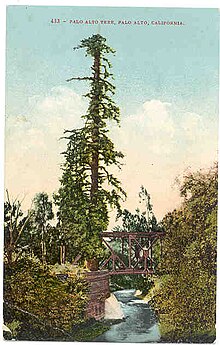El Palo Alto

El Palo Alto is a coast redwood (Sequoia sempervirens) tree located in El Palo Alto Park on the banks of San Francisquito Creek in Palo Alto, California, United States. El Palo Alto means the tall stick in Spanish.
El Palo Alto is 110 feet (33.5 meters) in height (compared to 134.6 feet or 41 meters in 1951), 90 inches (2.3 meters) in diameter, and has a crown spread of 40 feet (12 meters).
The tree is California Historical Landmark No. 2 (number 1 is the custom house in Monterey). It is recognized by the National Arborist Association and International Society of Arboriculture for its historical significance as "a campsite for the Portola Expedition Party of 1769"; being frequented by the Costanoan/Ohlone Indians; and for its use as a sighting tree by surveyors plotting out El Camino Real. The tree is depicted on the city of Palo Alto's official seal and on the seal of Stanford University. It is presumably the origin of the city's name.
The tree dates to approximately year 940 and is reportedly healthier today than 100 years ago.[2] El Palo Alto originally had twin trunks, but an 1887 flood in the San Francisquito arroyo tore off one of the two.
Because of its secluded location, El Palo Alto has become a popular sleeping spot for transients and an equally popular drinking spot for juvenile deliquents.
A plaque at the base of the tree bears the following inscription:
- Under this giant redwood, the Palo Alto, November 6 to 11, 1769, camped Portola and his band on the expedition that discovered San Francisco Bay, this was the assembling point for their reconnoitering parties. Here in 1774 Padre Palou erected a cross to mark the site of a proposed mission (which later was built at Santa Clara). The celebrated Pedro Font topographical map of 1776 contained the drawing of the original double trunked tree making the Palo Alto the first official living California landmark.
Notes
- ^ City of Palo Alto. El Palo Alto Historic Report
- ^ City of Palo Alto. El Palo Alto Historic Report
